All in the Family Room
Dawn Dellasanta-Swann writer
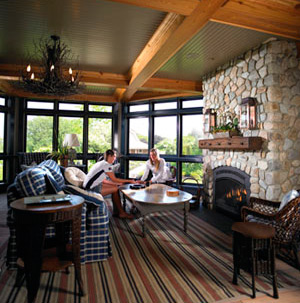 It’s the room where the fireplace flickers in January. Where the four-move checkmate is tested. The place where Pats fans watch Brady throw passes. Where homework clutters the desk and coffee tables invite slippered feet. The spot for books, watching cartoons, playing “Clue,” and taking naps. It’s the destination of familial migration. It’s the family room.
It’s the room where the fireplace flickers in January. Where the four-move checkmate is tested. The place where Pats fans watch Brady throw passes. Where homework clutters the desk and coffee tables invite slippered feet. The spot for books, watching cartoons, playing “Clue,” and taking naps. It’s the destination of familial migration. It’s the family room.
The family room has “a more casual atmosphere than the slowly declining parlor or living room,” says builder Ray Wiese. West Newton Designer Jill Litner Kaplan adds, “While the kitchen is traditionally thought of as the heart of the home, the family room might be an offshoot of that area.”
When speaking of the family room, those in the industry hearken back to the old “rec” room in the basement where kids played foosball after school. The course of a generation moved the rec room upstairs, changed its name to the den, and later bulged it into the great room of the last decade. Today’s family rooms are different, and their design is largely driven by the environment and the economy.
Woodmeister’s Chris Komenda has watched requests for buildings made with low VOC materials and excellent ventilation increase, especially from families with children learning to crawl or household members with allergies. She says people stay home more and luxuriate inside. “The trend is toward less showiness with a lot of personality inside the home.”
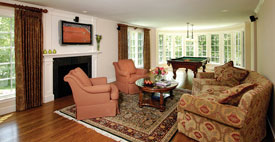 Williams and Spade designer Jeanne Racioppi doesn’t like to be wasteful. She’d rather pull out and repair a classic length of molding or a sticky drawer on a hundred year-old butler pantry than rip it apart and start over. Her clients, especially those of the younger generation, are well-educated in green living and appreciate repurposing.
Williams and Spade designer Jeanne Racioppi doesn’t like to be wasteful. She’d rather pull out and repair a classic length of molding or a sticky drawer on a hundred year-old butler pantry than rip it apart and start over. Her clients, especially those of the younger generation, are well-educated in green living and appreciate repurposing.
Judy O’Neil-Labins of Shafer O’Neil Interior Design says that her clients don’t even want to hear the word “green.” They want to assume it is so.
If environmental awareness tinted family rooms green, the economy put them on a diet. “People have become realistic about size,” says Wiese. O’Neil-Labins says, “Houses pushed the limit, but the sizes are coming down again.” Ten years ago the family room was a supersized 24 feet by 24 feet needing beefy furniture arrangements and gulping down hot and cool air. Post-boom consumers put their money into happiness. Maybe a soft, neutral oasis flooded with natural light flowing seamlessly through glass walls into a garden or stretch of woods.
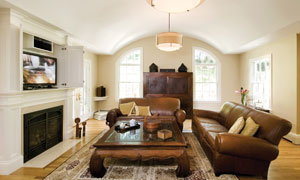 Uncertainty in the economy, the global status, and myriad other predicaments seem to have stimulated the need for authenticity at home. Wiese installs more gas fireplaces today than he has in the breadth of his career. Fifteen years ago, he would have been thrown out of town for lack of purism if he recommended a gas fireplace over the traditional wood burning hearth. These days he guesses 80 percent of new family rooms include fireplaces and 70 percent of those are gas powered.
Uncertainty in the economy, the global status, and myriad other predicaments seem to have stimulated the need for authenticity at home. Wiese installs more gas fireplaces today than he has in the breadth of his career. Fifteen years ago, he would have been thrown out of town for lack of purism if he recommended a gas fireplace over the traditional wood burning hearth. These days he guesses 80 percent of new family rooms include fireplaces and 70 percent of those are gas powered.
It takes careful consideration to select what is important for today’s family room. Kaplan put together a list of key ingredients essential for creating a family room that is comfy and cozy, stylish and unique. Included on this list are four key elements: storage, furnishings, surfaces, and technology.
Storage
If undergarments are an outfit’s foundation, built-in storage is a family room’s. Kaplan recommends a combination of closed cabinetry and exposed shelves. “Families acquire stuff at an unbelievable rate. A family room has to be able to accommodate.” Cabinets hide toys, games, and homework supplies. Shelves help to create atmosphere in an otherwise empty room. Shelves are a display area not only for books, but treasures or photographs that reflect a family’s life together.
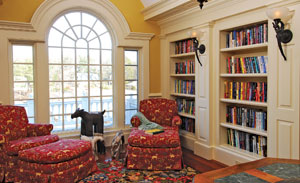 Whimsical Komenda likes secret passages and storage closets tucked behind trick hutches and sliding bookshelves. For the room with a view, Racioppi recommends window seats that capitalize on storage, seating, and space. A client need not have children or a family at home to enjoy a family room. Anyone can plan in comfy, cozy spots to entertain visiting family and friends. Racioppi turned a family room into a ship captain’s hideaway in Falmouth. The room was built on the caprice of a man who loved ships replete with stem to stern mahogany, a berth area for naps, and cabinets with chart drawers.
Whimsical Komenda likes secret passages and storage closets tucked behind trick hutches and sliding bookshelves. For the room with a view, Racioppi recommends window seats that capitalize on storage, seating, and space. A client need not have children or a family at home to enjoy a family room. Anyone can plan in comfy, cozy spots to entertain visiting family and friends. Racioppi turned a family room into a ship captain’s hideaway in Falmouth. The room was built on the caprice of a man who loved ships replete with stem to stern mahogany, a berth area for naps, and cabinets with chart drawers.
Furnishings
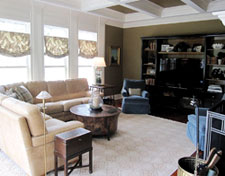 Across the board, designers advise to purchase the absolute best quality for the family budget. Take rugs. Designer Mollie Johnson stands by natural, vegetable-dyed wools that are luxuriously green by accident. They resist stains, clean well, and last forever. Racioppi says rugs don’t need to be traditional, only beautiful. Whether Persian, Tibetan, or modern, they should please the feet that meet there daily. “Many people have a hard time mentally. They think, ‘I wouldn’t spend that much for a rug in that room.’ The reality is, you can’t trash the high-end carpets. The lanolin is resistant to stains.”
Across the board, designers advise to purchase the absolute best quality for the family budget. Take rugs. Designer Mollie Johnson stands by natural, vegetable-dyed wools that are luxuriously green by accident. They resist stains, clean well, and last forever. Racioppi says rugs don’t need to be traditional, only beautiful. Whether Persian, Tibetan, or modern, they should please the feet that meet there daily. “Many people have a hard time mentally. They think, ‘I wouldn’t spend that much for a rug in that room.’ The reality is, you can’t trash the high-end carpets. The lanolin is resistant to stains.”
Johnson says the same goes for the sofa. Cheap couches are quick to show their springs. And don’t buy a matching sofa set. It’s a waste of creative effort.
Kaplan, Racioppi, and Johnson believe in the power of a custom palette using different coordinating fabrics to outfit the elements of a family room. Johnson prefers fabrics like linens, velvets, and chenilles that combine durability with practicality. Budget polyesters simply don’t clean well. Favorite colors for family rooms are neutrals like whites, tans, beiges, or browns with snappy accents of greens and oranges.
 Kaplan covers the investment pieces (couches and chairs) in tweedy, textured, or patterned chenilles. “Opt in for the fabric protection on everything. Even in homes that never allow food on the sofa, something always happens,” she warns. Like a fun pair of shoes, Kaplan covers ottomans – that double up as storage pieces – in grass cloth, faux alligator, or faux shagreen.
Kaplan covers the investment pieces (couches and chairs) in tweedy, textured, or patterned chenilles. “Opt in for the fabric protection on everything. Even in homes that never allow food on the sofa, something always happens,” she warns. Like a fun pair of shoes, Kaplan covers ottomans – that double up as storage pieces – in grass cloth, faux alligator, or faux shagreen.
If storage ensures a place for everything, then seating promises a place for everyone. Whether sectionals, chaises, or a smattering of swiveling club chairs, be sure to have as many as appropriate to the size of the room. Keep furniture in scale with the room, meaning no potbellied sofas in a smallish space or lonely delicates in a large one.
Surfaces
 Johnson likes a big, solid, square coffee table with plenty of room for bowls of popcorn and the inevitable coffee table book. Like seating, be sure to have enough surfaces for everybody to use.
Johnson likes a big, solid, square coffee table with plenty of room for bowls of popcorn and the inevitable coffee table book. Like seating, be sure to have enough surfaces for everybody to use.
Desks provide an overlap between work and play and provide an extra surface for lighting and storage for paperwork and office supplies.
Technology
The trend is to hide electronics. The exception is the home computer. Apple’s Mac line looks good and allows parents to monitor what’s happening on that sleek, streamlined screen. “You’ve worked so hard to make a room chic and stylish, you want the computer to be stylish as well,” says Kaplan.
Flat screen TVs loom large in many family rooms. Choose the right size for your room. Don’t buy a screen with a viewing distance of fifteen feet for a room that’s only twelve. TV sizes aren’t likely to change much now. Neither is the size of your family room. Buy a TV that works for the room; upgrade the quality, not the size, as time passes. Accessorize with an exquisite sound system.
In addition to ambient and reading light, Kaplan recommends recessed lights on a dimmer switch that can serve multiple purposes, like spotlighting projects spread out on a desk, a jigsaw on the coffee table, or be used for close work like sewing and needlepoint. At game time the lights can be dimmed to give a cozy atmosphere.
Finally, whether you need a builder, a renovator, a designer, or all of the above, choose a team with as much care as you would a spouse. Or at least a long-term roommate.
Racioppi says that by project’s end, she knows just about everything there is to know about her client, short of what is kept in the dresser drawer. Because of that, the dynamic needs to be good. The designer has to be able to advocate for the client and should have a solid understanding of construction-related issues. Also important, says Racioppi, is that the designer not get in the way of the client’s taste.
Consider the spectrum of time and cost ranges. Large companies like Woodmeister have the resources and manpower to work fast. Racioppi did a sort of extreme makeover on a 7,500 square foot colonial in two weeks for a family of four. “It could have been on TV,” she says. On the other hand, another client’s home has been in the making for almost three years.
Take their advice and ask yourself some questions. Whose papers will be spread across the desk, fluttering to the floor when the breeze gusts through the sliders? Whose stocking feet will polish the coffee table? Who will be playing games? Who will come from near and far to celebrate the passing of years? Think about which treasures will fill the cabinets and shelves. Photographs or video games? A collection of books? Baskets of scrap yarn and fabric? Think of what a family room means to your family and decide how you want to feel when you are in it. Plan around the family, find the focus and the feeling.
Sources:
© 2010 Elm Bank Media | Beth Furman, Publisher | Beth@ElmBankMedia.com


recent comments